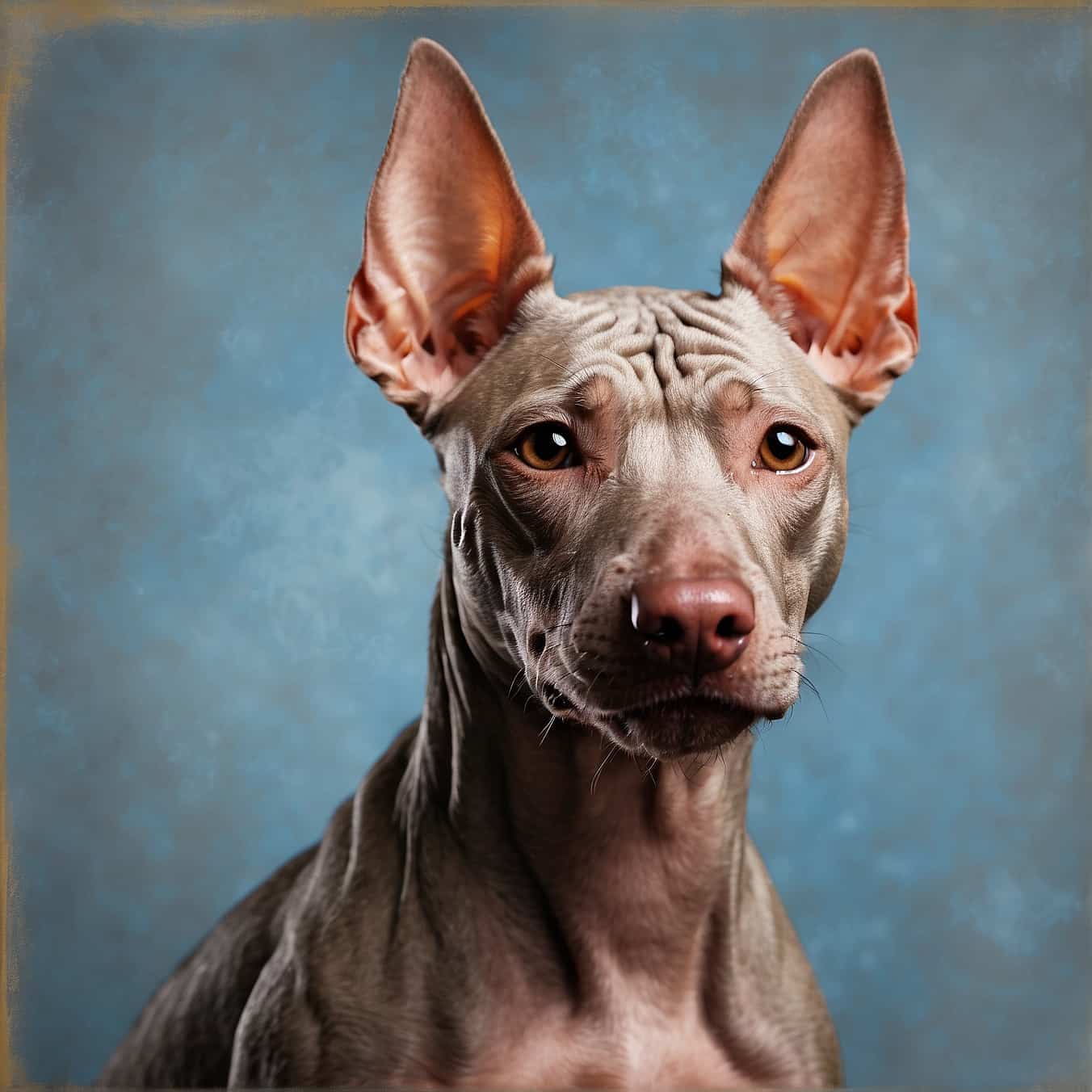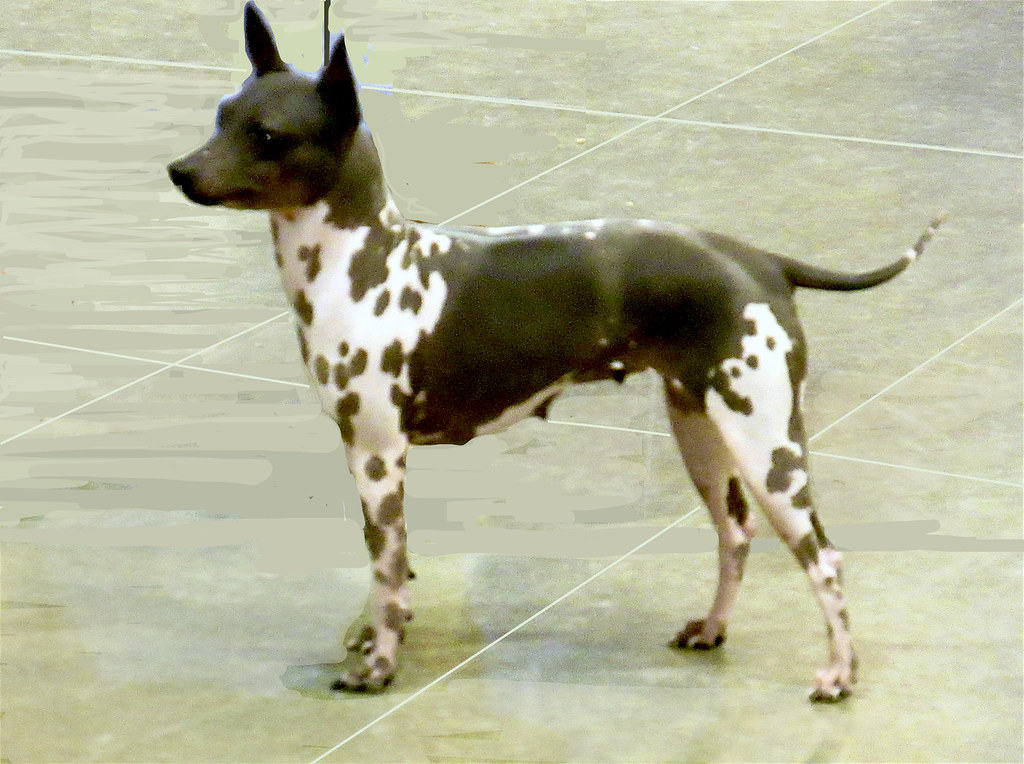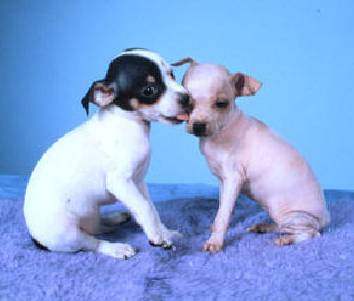American Hairless Terriers have a unique and distinctive appearance. Delve into their history, learn about the care they deserve, and discover the gentle and affectionate nature that sets American Hairless Terriers apart.

| Category (Explanation) | Breed Information |
|---|---|
| Year of Breed Conception | 1970s |
| Country of Origin | United States |
| Weight (lbs & kg) (Male) | 12-16 lbs (5.5-7.3 kg) |
| Weight (lbs & kg) (Female) | 12-16 lbs (5.5-7.3 kg) |
| Coat Type | Hairless (with a coated variety) |
| Color Variations | Various colors and patterns |
| Shedding Level (Low, Moderate, High) | Low |
| Height (cm & in) | 12-16 inches (30-41 cm) |
| Breed Size | Small to medium |
| Trainability (Low, Moderate, High) | High |
| Mental Needs (Low, Moderate, High) | Moderate |
| Intelligence Level (Low, Moderate, High) | High |
| Energy Level (Low, Moderate, High) | Moderate |
| Agility (Low, Moderate, High) | Moderate |
| Loyalty (Low, Moderate, High) | High |
| Playfulness (Low, Moderate, High) | High |
| Exercise Needs | Moderate exercise and mental stimulation |
| Guarding Proficiency (Low, Moderate, High) | Low |
| Sociability with Children (Low, Moderate, High) | High |
| Barking Level (Low, Moderate, High) | Moderate |
| Digging Tendency (Low, Moderate, High) | Low |
| Destructive Behavior (Low, Moderate, High) | Low |
| Drooling Level (Low, Moderate, High) | Low |
| Obedience Level (Low, Moderate, High) | High |
| Apartment Friendly (Yes/No) | Yes, with proper exercise |
| Inherent Prey Drive | Moderate |
| Physical Risk to Others (Low, Moderate, High) | Low |
| Travel Fatality Risk (Low, Moderate, High) | Low |
| Allergen Potential | Low |
| Health Concerns (List of Common Health Concerns) | Skin care, sun sensitivity |
| Average Life Expectancy (Life Expectancy in Years) | 12-16 years |
Woof Mastery is reader supported and our articles may contain affiliate links.
Instead of running third party ads that we have no control of we only use links from high-quality companies we are directly partnered with. Making use of these links come at no cost to you our reader, and in many cases have the extra benefit of discounted rates or sign up bonuses.
If you’re interested you can read more about our affiliate policy here.
We appreciate your support and always insure that the products and services we recommend are high-quality, helpful and relevant to the subject at hand!
The American Hairless Terrier is a relatively modern breed with roots in the United States. The breed’s development began in the 1970s when a hairless puppy named Josephine was born in a litter of Rat Terriers in Louisiana. This event sparked the interest of a Louisiana schoolteacher, Edwin Scott, who saw the potential for creating a new breed. The American Hairless Terrier was selectively bred from Rat Terriers to maintain its hairless trait.
The breed’s recognition grew, and in 2004, it was officially recognized by the American Kennel Club . Today, the American Hairless Terrier is known for its lively personality and unique appearance, offering a distinctive option for dog enthusiasts seeking a hypoallergenic companion.

American Hairless Terriers have a unique and distinctive appearance. What makes them special is their unique appearance and their gentle and affectionate nature. Delve into their history, learn about the care they deserve, and discover what sets American Hairless Terriers apart. American Hairless Terriers are special for their one-of-a-kind appearance and affectionate disposition, adding a touch of individuality to the lives of their owners.
The American Hairless Terrier doesn’t have a specific traditional role rooted in history, as its development as a breed is more recent. However, they have found their place as versatile and affectionate companions. These terriers are known for their unique and distinctive appearance, making them cherished pets and loving family members. Their role today is primarily that of a beloved and low-maintenance companion, appreciated for their gentle and affectionate nature.
American Hairless Terriers have a unique and distinctive appearance. They are characterized by their unique appearance and gentle nature. These terriers can be loving and make wonderful family pets. They are known for their unique appearance and require training and socialization to ensure they are well-behaved and gentle family pets.
American Hairless Terriers have a unique and distinctive appearance. They are typically affectionate and gentle dogs. Their loving nature makes them great companions. However, they may exhibit some terrier stubbornness at times. Training and socialization are essential to ensure they develop into well-adjusted pets. Their adaptability and unique appearance make them stand out among terrier breeds.
American Hairless Terriers have a unique and distinctive appearance. They are small to medium-sized dogs with a well-proportioned, athletic build. Their hairless coat is smooth, often with some sparse hair on the head, ears, and paws. Their skin is smooth, firm, and warm to the touch, with various colors and patterns. They have a well-shaped head with a defined stop, and their eyes are dark and expressive. Ears can be erect or semi-erect, and their tail is carried high and tapers to a point. These terriers are known for their elegant and sleek appearance, and their lack of coat makes them stand out in the terrier world.
American Hairless Terriers have a unique appearance due to their hairless nature. Their skin is typically pink or gray, and it’s exposed without a coat. The lack of fur makes their skin color the most prominent feature. Their skin can be mottled, spotted, or have various pigmentation patterns. The most common coat color for American Hairless Terriers is pink, but variations can include gray or spots of different colors on their skin.
American Hairless Terriers have a unique appearance due to their hairless coat, which is often pinkish-gray or black with pink skin. Their lack of hair adds to their distinctive and striking look.
American Hairless Terriers are a virtually hairless breed, making them ideal for individuals with allergies or those who prefer minimal shedding. However, it’s essential to note that the hairless variety may still have some body oil or light fuzz, which requires care. While they are generally low-shedding, proper skincare, including protection from the sun and moisturizing, is crucial to maintain the health of their exposed skin.
American Hairless Terriers, as the name suggests, do not have a coat and are relatively low-maintenance in terms of grooming. Grooming habits for American Hairless Terriers include:
American Hairless Terriers have a moderate to high activity level. These lively and intelligent terriers enjoy playtime and interactive activities. Daily walks, play sessions, and mental stimulation are important to keep them happy. They may also excel in canine sports and agility. While not excessively hyperactive, American Hairless Terriers benefit from regular exercise to maintain their health and prevent boredom. Tailor their activities to their individual preferences and energy levels.
American Hairless Terriers are intelligent and curious dogs. They tend to be quick learners and are responsive to positive reinforcement training. Their intelligence, combined with an energetic nature, makes them well-suited for various activities and tasks. American Hairless Terriers thrive on mental stimulation and enjoy engaging with their owners in play and training sessions.
American Hairless Terriers have mental needs that include engaging activities to stimulate their minds. Puzzle toys, obedience training, and interactive play are beneficial for their mental well-being.
Social Interaction: American Hairless Terriers are social dogs that thrive on regular interaction with their human family members. Providing companionship and attention helps prevent feelings of loneliness and anxiety.
Exercise: Regular physical exercise is essential for American Hairless Terriers to maintain mental health. Engage them in play and activities that provide both physical and mental stimulation.
Training and Obedience: Obedience training is beneficial for American Hairless Terriers, providing mental stimulation and reinforcing the bond with owners. Positive-reinforcement training methods work well with this breed.
Routine and Structure: Establish a consistent daily routine to provide American Hairless Terriers with a sense of security and reduce anxiety. Dogs generally thrive on routine and structure.
Affection and Attention: Show affection and spend quality time with American Hairless Terriers to fulfill their need for attention and companionship. They form strong bonds with their owners.
Socialization: Early socialization is crucial to ensure American Hairless Terriers become well-adjusted dogs. Exposure to various people, animals, and environments helps build confidence.
Safe Environment: Create a safe and comfortable environment at home where American Hairless Terriers can relax and feel secure. Provide a designated space for them to retreat to if needed.
Consistency: Consistency in training and daily routines helps American Hairless Terriers feel more secure and confident in their environment.
Enter The Woof Mastery

Prospective owners of American Hairless Terriers should be aware of their specific care requirements. Being hairless, these dogs may have special skin care needs, including protection from sun exposure. Regular grooming and attention to their skin health are essential. Additionally, these terriers are known for their intelligence and energy, requiring mental and physical stimulation. Potential owners should be prepared for a lively and affectionate companion that thrives in an environment that provides both mental and physical exercise.
American Hairless Terriers typically have a low risk to others due to their friendly and affectionate nature. Proper socialization and training are important to ensure positive interactions. Responsible ownership, early exposure to various environments, and understanding individual temperament contribute to a well-behaved American Hairless Terrier.
American Hairless Terriers can be good family pets. They are often energetic and enjoy playtime with children. As with any dog, early socialization and positive interactions are important to ensure a harmonious relationship between the dog and children.
American Hairless Terriers may have varying responses to water. Some individuals may enjoy swimming, while others may not be as comfortable. Introduce them to water gradually, and observe their comfort level. Always prioritize safety and use a canine life vest if needed, especially in situations where they may be at risk of fatigue.
Remember that positive reinforcement and early socialization are key to raising a well-behaved American Hairless Terrier.
American Hairless Terriers may exhibit a moderate level of vocalization. Like many terriers, they can bark to alert their owners and express themselves. Training and socialization play a crucial role in managing their barking tendencies and ensuring they communicate appropriately.
American Hairless Terriers are adaptable and can thrive in various living environments. They do well in homes with active families and enjoy regular play and exercise. While they can adapt to apartment living, they need daily walks and mental stimulation. Proper socialization is essential to ensure they are comfortable around new people and situations.
American Hairless Terriers are a relatively small breed, making them more adaptable to various travel conditions. Ensure they are safely secured during travel, either in a crate or with a suitable seatbelt harness. Monitor them for signs of discomfort or stress and make necessary adjustments to ensure their well-being. Provide familiar items for comfort, and plan for regular breaks during long journeys.
American Hairless Terriers may be prone to certain health concerns. While not all individuals will experience these issues, it’s essential for American Hairless Terrier owners to be aware of potential health problems and collaborate with veterinarians to maintain their pets’ well-being. Common health concerns in American Hairless Terriers include:
Regular veterinary check-ups, a balanced diet, proper dental care, and protection from extreme weather conditions can help mitigate some of these health concerns. It’s crucial for American Hairless Terrier owners to work closely with their veterinarians to monitor their pets’ health and address any issues promptly.
Proper nutrition is crucial for the health and well-being of American Hairless Terriers. Here are some nutritional habits and best practices to consider for this breed:
Breed-Specific Laws (BSL): American Hairless Terriers may be subject to breed-specific laws (BSL) in certain areas. These laws are often enacted at the local or municipal level and can vary widely from one jurisdiction to another.
Types of Restrictions: The specific restrictions imposed on American Hairless Terriers under BSL can include mandatory spaying/neutering, special licensing, liability insurance requirements, muzzling in public, and, in some cases, bans on ownership. The severity of these restrictions depends on local regulations.
Rationale for BSL: BSL is typically implemented based on concerns about public safety and perceived risks associated with specific breeds, often due to incidents involving dog attacks. While American Hairless Terriers are not inherently aggressive, they can be affected by BSL due to their physical resemblance to breeds that are sometimes included in these laws.
Controversy: It’s important to note that BSL is a controversial topic. Critics argue that it unfairly targets breeds rather than addressing individual dog behavior and that responsible ownership and training should be emphasized instead of breed-specific restrictions.
Local Regulations: To determine if there are breed-specific laws or restrictions regarding American Hairless Terriers in your area, you should check with your local animal control or government authorities. Be aware of and comply with any local regulations to ensure that you are in compliance with the law while owning an American Hairless Terrier.
Woof Mastery is reader supported and our articles may contain affiliate links.
Instead of running third party ads that we have no control of we only use links from high-quality companies we are directly partnered with. Making use of these links come at no cost to you our reader, and in many cases have the extra benefit of discounted rates or sign up bonuses.
If you’re interested you can read more about our affiliate policy here.
We appreciate your support and always insure that the products and services we recommend are high-quality, helpful and relevant to the subject at hand!
Myth 1: American Hairless Terriers are hypoallergenic.
Myth 2: They need special skincare due to being hairless.
Myth 3: They are fragile and delicate.
Myth 4: They are high-maintenance.
Myth 5: They are prone to skin issues.
Famous American Hairless Terrier examples are not as widely documented due to the breed’s relative rarity. However, these dogs are cherished companions for those who appreciate their unique appearance and hypoallergenic qualities.
The American Hairless Terrier carries cultural significance in various domains:
As a relatively newer breed, the American Hairless Terrier doesn’t have a widely recognized historical owner. However, these terriers have gained popularity for their unique appearance and hypoallergenic qualities, making them sought after as companion animals.
American Hairless Terriers, being a relatively rare breed, have faced specific challenges:
The American Hairless Terrier is a relatively modern breed that originated in the United States. It was developed from the Rat Terrier, with the hairless gene mutation occurring spontaneously. Breeds that contributed to the Rat Terrier’s development include:
The American Hairless Terrier, with its modern and distinctive appearance, offers a unique and low-maintenance pet experience. Their playful nature and adaptability make them suitable for families. Minimal grooming needs appeal to those seeking a companion with less coat care. As energetic and intelligent dogs, they thrive in various environments and engage actively with their owners.